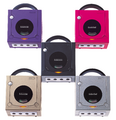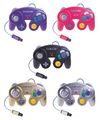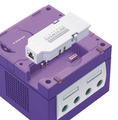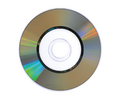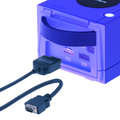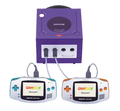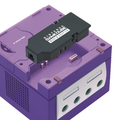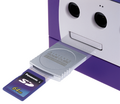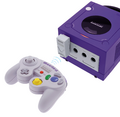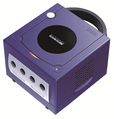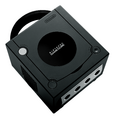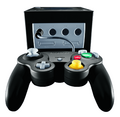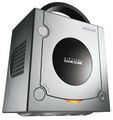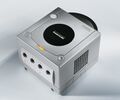Difference between revisions of "Nintendo GameCube"
From Sega Retro
old>Hivebrain m |
SEGAAA2004 (talk | contribs) |
||
| (49 intermediate revisions by 14 users not shown) | |||
| Line 1: | Line 1: | ||
| − | + | {{ConsoleBob | |
| + | | logo=Nintendo Gamecube Logo.svg | ||
| + | | consoleimage=Gamecube.jpg | ||
| + | | name= | ||
| + | | maker=[[Nintendo]], [[Panasonic]] (Panasonic Q) | ||
| + | | variants=Panasonic Q | ||
| + | | add-ons=Game Boy Player | ||
| + | | releases={{releasesGC | ||
| + | | gc_date_us=2001-11-18 | ||
| + | | gc_rrp_us=199.95{{ref|1=https://web.archive.org/web/20010609211800/http://www.nintendo.com/news/news_articles.jsp?articleId=3978}} | ||
| + | | gc_date_eu=2002-05-03{{magref|cube|3|14}} | ||
| + | | gc_date_jp=2001-09-14 | ||
| + | | gc_date_au=2002-05-17 | ||
| + | }} | ||
| + | }} | ||
| + | The '''Nintendo GameCube''' (ニンテンドーゲームキューブ), originally codenamed '''Dolphin''' and officially abbreviated '''NGC''' in Japan and '''GCN''' in North America, is a video game console released by [[Nintendo]] in 2001 as a successor to the [[Nintendo 64]]. It is a sixth-generation system, designed to compete primarily with the [[PlayStation 2]] and [[Xbox]] and to a limited degree, the [[Sega Dreamcast]]. The GameCube was Nintendo's home platform of choice until the release of the [[Wii]] in 2006. | ||
| + | |||
| + | See ''[[Sega Dreamcast/Hardware comparison|Sega Dreamcast hardware comparison]]'' for a technical comparison between the Dreamcast, PS2, GameCube and Xbox hardware. The Xbox and GameCube were considered to have been the most powerful consoles of that generation, with the Xbox stronger in certain aspects while the GameCube was stronger in other aspects. | ||
==Overview== | ==Overview== | ||
| − | The Nintendo | + | The GameCube is considered to be one of Nintendo's least successful video game consoles, as despite high praise in regards to build quality and a strong line of first-party titles, a series of poor management decisions led it to be abandoned by many third party publishers within three years. Though more GameCubes were sold worldwide than Dreamcasts, sales lagged throughout the generation behind the Xbox in PlayStation 2 (though in Japan, the GameCube outsold the Xbox). |
| + | |||
| + | The GameCube took a family-friendly approach to the video game industry, ultimately losing out on more "mature" titles and failing to attract the majority of the gaming public. Its use of proprietary mini-discs with less storage space also hindered development and meant that unlike the PlayStation 2, the system could not play DVDs (though this was fixed in a Japanese-only special model, the Panasonic Q). On a technical level, the GameCube is widely considered to be more powerful than the PlayStation 2, but less powerful than the Xbox. | ||
| − | + | As with the Xbox, the GameCube is said to have been inspired by the Dreamcast (and to some degree, the [[Sega Saturn]]), not only by the positioning of the features of its controller, but by the use of analogue triggers and the connectivity of the [[Game Boy Advance]] (in which parallels can be drawn with Sega's [[VMU]]s). The GameCube would evolve over time - the addition of the Game Boy Player giving it the ability to play Game Boy Advance games (and earlier [[Game Boy]] handheld games), and support for GameCube discs and controllers being added to the console's successor, the Wii. The GameCube could connect to the internet much like the Dreamcast, but very few titles made use of this technology and the modem needed to be purchased separately. | |
| − | == | + | ==Sega support== |
| − | + | Following the demise of the Sega Dreamcast, Sega spread its wings across all three of its console rivals throughout the remainder of the console generation. Announcing support for the system in May 2001 (with seven games in the pipeline){{ref|https://web.archive.org/web/20021117053145/http://www.sega.jp/release/nr010518_1.html}}, the Nintendo GameCube became the console of choice for Sega's family friendly games, the ''[[Sonic the Hedgehog]]'' series being more prominent on the GameCube than on other platforms. The retooled release of ''[[Monkey Ball]]'', ''[[Super Monkey Ball]]'' took up residence on the GameCube before branching out to other platforms in 2005, as did successors to ''[[Phantasy Star Online]]''; ''[[Phantasy Star Online Episode I & II]]'' (which saw a port to the Xbox in the following year) and ''[[Phantasy Star Online Episode III]]''. | |
| − | + | The [[Sonic Team]] original, ''[[Billy Hatcher and the Giant Egg]]'' was released exclusively for the GameCube (and later PC), as was the only home port of ''[[Beach Spikers: Virtua Beach Volleyball]]'' and new ventures such as ''[[Amazing Island]]''. Sega also joined with Nintendo (and [[Namco]]) at this time to create the [[Triforce]] arcade hardware, and its [[Amusement Vision]] division created ''[[F-Zero GX]]'', a GameCube exclusive which became one of the most popular racing games on the platform. | |
| − | |||
| − | |||
| − | |||
| − | |||
| − | |||
| − | |||
| − | |||
| − | |||
| − | |||
| − | |||
| − | |||
| − | |||
| − | |||
| − | |||
| − | |||
| − | |||
| − | |||
| − | + | Like many publishers, Sega began to withdraw support by 2003, starting with its line of sports games, although it did not abandon the platform until the latter half of 2006. Sega are thought to have benefited from the GameCube in its early years of service, although by the middle of the decade, found itself supporting all three consoles in relatively equal measure (save for the PlayStation 2, which saw much greater support from the company in Japan, and the aforementioned sports titles). | |
| − | |||
| − | |||
| − | |||
| − | |||
| − | |||
| − | |||
| − | |||
| − | |||
| − | |||
| − | |||
| − | |||
| − | |||
| − | |||
| − | |||
| − | |||
| − | |||
| − | |||
| − | |||
| − | |||
| − | |||
| − | |||
| − | |||
| − | |||
| − | |||
| − | |||
| − | |||
| − | |||
| − | |||
| − | |||
| − | |||
| − | |||
| − | |||
| − | |||
| − | === | + | ==List of Sega Games for the GameCube== |
| − | + | {{BulletPointGameList|GC}} | |
| − | |||
| − | |||
| − | |||
| − | |||
| − | |||
| − | |||
| − | |||
| − | |||
| − | |||
| − | |||
| − | === | + | ===By region=== |
| − | * | + | *[[List of Nintendo GameCube games in Australia]] |
| − | * | + | *[[List of Nintendo GameCube games in Brazil]] |
| − | * | + | *[[List of Nintendo GameCube games in Canada]] |
| − | * | + | *[[List of Nintendo GameCube games in France]] |
| − | * | + | *[[List of Nintendo GameCube games in Germany]] |
| − | * | + | *[[List of Nintendo GameCube games in Italy]] |
| − | * | + | *[[List of Nintendo GameCube games in Japan]] |
| − | * | + | *[[List of Nintendo GameCube games in Mexico]] |
| − | * | + | *[[List of Nintendo GameCube games in Russia]] |
| − | * | + | *[[List of Nintendo GameCube games in Spain]] |
| − | * | + | *[[List of Nintendo GameCube games in Taiwan]] |
| − | + | *[[List of Nintendo GameCube games in the United Kingdom]] | |
| − | + | *[[List of Nintendo GameCube games in the United States]] | |
| − | |||
| − | |||
| − | |||
| − | |||
| − | * | ||
| − | |||
| − | * | ||
| − | |||
| − | |||
| − | |||
| − | |||
| − | |||
| − | |||
| − | |||
| − | + | ==Other GameCube games also released for Sega systems== | |
| + | {{NonSegaList|GC}} | ||
| − | == | + | ==Promotional images== |
| − | + | ===Nintendo SpaceWorld 2000=== | |
| − | + | <gallery> | |
| − | + | NintendoSpaceworld2000PressDisc GAMECUBE5COLORA.png | |
| − | + | NintendoSpaceworld2000PressDisc GAMECUBE5COLORB.png | |
| − | + | NintendoSpaceworld2000PressDisc GAMECUBE6VIEW.png | |
| − | + | NintendoSpaceworld2000PressDisc GAMECUBEBLUE.png | |
| − | + | NintendoSpaceworld2000PressDisc GAMECUBEBROADBAND.png | |
| − | + | NintendoSpaceworld2000PressDisc GAMECUBEDIGICARD.png | |
| + | NintendoSpaceworld2000PressDisc GAMECUBEDISC.png | ||
| + | NintendoSpaceworld2000PressDisc GAMECUBEDVCABLE.png | ||
| + | NintendoSpaceworld2000PressDisc GAMECUBEGBACABLE.png | ||
| + | NintendoSpaceworld2000PressDisc GAMECUBEMODEM.png | ||
| + | NintendoSpaceworld2000PressDisc GAMECUBESD.png | ||
| + | NintendoSpaceworld2000PressDisc GAMECUBEWIRELESS.png | ||
| + | </gallery> | ||
| − | == | + | ===Later=== |
| − | + | <gallery> | |
| + | GCGBAMediaInformation dol hrdwr&cntrl indigo 05.png | ||
| + | GCGBAMediaInformation dol hardware angle 02.png | ||
| + | GCGBAMediaInformation dol memorycard 01.png | ||
| + | GCGBAMediaInformation dol hrdwr&cntrl 01.png | ||
| + | GCGBAMediaInformation dol hrdwr black angle 04.png | ||
| + | GCGBAMediaInformation dol hrdwr&cntrl black 05.png | ||
| + | GCGBAMediaInformation dol hrdwr&cntrl black 04.png | ||
| + | NintendoHolidayPressCD2003 Platinum Nintendo GameCube 1.jpg | ||
| + | NintendoHolidayPressCD2003 Platinum Nintendo GameCube 2.jpg | ||
| + | NintendoHolidayPressCD2003 Platinum Nintendo GameCube 3.jpg | ||
| + | </gallery> | ||
| − | + | ==References== | |
| + | <references/> | ||
| − | + | {{NonSegaConsoles}} | |
| − | |||
Latest revision as of 22:09, 5 March 2024

| |||||||||||||||||||||||||
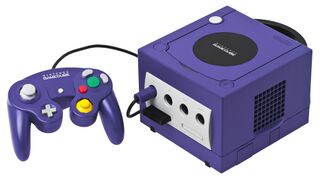
| |||||||||||||||||||||||||
| Nintendo GameCube | |||||||||||||||||||||||||
|---|---|---|---|---|---|---|---|---|---|---|---|---|---|---|---|---|---|---|---|---|---|---|---|---|---|
| Manufacturer: Nintendo, Panasonic (Panasonic Q) | |||||||||||||||||||||||||
| Variants: Panasonic Q | |||||||||||||||||||||||||
| Add-ons: Game Boy Player | |||||||||||||||||||||||||
|
The Nintendo GameCube (ニンテンドーゲームキューブ), originally codenamed Dolphin and officially abbreviated NGC in Japan and GCN in North America, is a video game console released by Nintendo in 2001 as a successor to the Nintendo 64. It is a sixth-generation system, designed to compete primarily with the PlayStation 2 and Xbox and to a limited degree, the Sega Dreamcast. The GameCube was Nintendo's home platform of choice until the release of the Wii in 2006.
See Sega Dreamcast hardware comparison for a technical comparison between the Dreamcast, PS2, GameCube and Xbox hardware. The Xbox and GameCube were considered to have been the most powerful consoles of that generation, with the Xbox stronger in certain aspects while the GameCube was stronger in other aspects.
Contents
Overview
The GameCube is considered to be one of Nintendo's least successful video game consoles, as despite high praise in regards to build quality and a strong line of first-party titles, a series of poor management decisions led it to be abandoned by many third party publishers within three years. Though more GameCubes were sold worldwide than Dreamcasts, sales lagged throughout the generation behind the Xbox in PlayStation 2 (though in Japan, the GameCube outsold the Xbox).
The GameCube took a family-friendly approach to the video game industry, ultimately losing out on more "mature" titles and failing to attract the majority of the gaming public. Its use of proprietary mini-discs with less storage space also hindered development and meant that unlike the PlayStation 2, the system could not play DVDs (though this was fixed in a Japanese-only special model, the Panasonic Q). On a technical level, the GameCube is widely considered to be more powerful than the PlayStation 2, but less powerful than the Xbox.
As with the Xbox, the GameCube is said to have been inspired by the Dreamcast (and to some degree, the Sega Saturn), not only by the positioning of the features of its controller, but by the use of analogue triggers and the connectivity of the Game Boy Advance (in which parallels can be drawn with Sega's VMUs). The GameCube would evolve over time - the addition of the Game Boy Player giving it the ability to play Game Boy Advance games (and earlier Game Boy handheld games), and support for GameCube discs and controllers being added to the console's successor, the Wii. The GameCube could connect to the internet much like the Dreamcast, but very few titles made use of this technology and the modem needed to be purchased separately.
Sega support
Following the demise of the Sega Dreamcast, Sega spread its wings across all three of its console rivals throughout the remainder of the console generation. Announcing support for the system in May 2001 (with seven games in the pipeline)[3], the Nintendo GameCube became the console of choice for Sega's family friendly games, the Sonic the Hedgehog series being more prominent on the GameCube than on other platforms. The retooled release of Monkey Ball, Super Monkey Ball took up residence on the GameCube before branching out to other platforms in 2005, as did successors to Phantasy Star Online; Phantasy Star Online Episode I & II (which saw a port to the Xbox in the following year) and Phantasy Star Online Episode III.
The Sonic Team original, Billy Hatcher and the Giant Egg was released exclusively for the GameCube (and later PC), as was the only home port of Beach Spikers: Virtua Beach Volleyball and new ventures such as Amazing Island. Sega also joined with Nintendo (and Namco) at this time to create the Triforce arcade hardware, and its Amusement Vision division created F-Zero GX, a GameCube exclusive which became one of the most popular racing games on the platform.
Like many publishers, Sega began to withdraw support by 2003, starting with its line of sports games, although it did not abandon the platform until the latter half of 2006. Sega are thought to have benefited from the GameCube in its early years of service, although by the middle of the decade, found itself supporting all three consoles in relatively equal measure (save for the PlayStation 2, which saw much greater support from the company in Japan, and the aforementioned sports titles).
List of Sega Games for the GameCube
- 18 Wheeler: American Pro Trucker (2002)
- Amazing Island (2004)
- Beach Spikers: Virtua Beach Volleyball (2002)
- Billy Hatcher and the Giant Egg (2003)
- Bleach GC: Tasogare ni Mamieru Shinigami (2005)
- Crazy Taxi (2001)
- Derby Tsuku 3: Derby Ba wo Tsukurou! (2003)
- Duo Pack: Sonic Heroes/Super Monkey Ball 2 (2005)
- F-Zero GX (2003)
- Gekitou Pro Yakyuu: Mizushima Shinji Allstars vs Pro Yakyuu (2003)
- Home Run King (2002)
- Mr. Incredible: Kyouteki Underminer Toujou (2006)
- NBA 2K2 (2002)
- NBA 2K3 (2002)
- NCAA College Basketball 2K3 (2002)
- NCAA College Football 2K3 (2002)
- NFL 2K3 (2002)
- NHL 2K3 (?)
- Phantasy Star Online Episode I & II (?)
- Phantasy Star Online Episode I & II & III Trilogy (?)
- Phantasy Star Online Episode III: C.A.R.D. Revolution (2003)
- Puyo Pop Fever (2004)
- Samurai Jack: The Shadow of Aku (2004)
- Sega Soccer Slam (2002)
- Shadow the Hedgehog (2005)
- Skies of Arcadia (2002)
- Sonic Adventure 2-Pack (?)
- Sonic Adventure 2: Battle (2001)
- Sonic Adventure DX: Director's Cut (2003)
- Sonic Gems Collection (2005)
- Sonic Heroes (2003)
- Sonic Mega Collection (2002)
- Sonic Riders (2006)
- Spartan: Total Warrior (2005)
- Super Monkey Ball (2001)
- Super Monkey Ball 2 (2002)
- Super Monkey Ball 2 Pack (2004)
- Super Monkey Ball Adventure (2006)
- Virtua Quest (2004)
- Virtua Striker 3 Ver. 2002 (2002)
- Worms 3D (2003)
By region
- List of Nintendo GameCube games in Australia
- List of Nintendo GameCube games in Brazil
- List of Nintendo GameCube games in Canada
- List of Nintendo GameCube games in France
- List of Nintendo GameCube games in Germany
- List of Nintendo GameCube games in Italy
- List of Nintendo GameCube games in Japan
- List of Nintendo GameCube games in Mexico
- List of Nintendo GameCube games in Russia
- List of Nintendo GameCube games in Spain
- List of Nintendo GameCube games in Taiwan
- List of Nintendo GameCube games in the United Kingdom
- List of Nintendo GameCube games in the United States
Other GameCube games also released for Sega systems
Promotional images
Nintendo SpaceWorld 2000
Later
References
- ↑ http://www.nintendo.com/news/news_articles.jsp?articleId=3978 (Wayback Machine: 2001-06-09 21:18)
- ↑ Cube, "Issue Three" (UK; 2002-02-14), page 14
- ↑ http://www.sega.jp/release/nr010518_1.html (Wayback Machine: 2002-11-17 05:31)
| Non-Sega consoles |
|---|
| Nintendo |
| Nintendo Entertainment System (1983) | Game Boy (1989) | Super Nintendo Entertainment System (1990) | Nintendo 64 (1996) | Game Boy Color (1998) | Game Boy Advance (2001) | Nintendo GameCube (2001) | Nintendo DS (2004) | Wii (2006) | Nintendo 3DS (2011) | Wii U (2012) | Nintendo Switch (2017) |
| Sony |
| PlayStation (1994) | PlayStation 2 (2000) | PlayStation Portable (2004) | PlayStation 3 (2006) | PlayStation Vita (2011) | PlayStation 4 (2013) | PlayStation 5 (2020) |
| Microsoft |
| Xbox (2001) | Xbox 360 (2005) | Xbox One (2013) | Xbox Series X (2020) |
| Mobile |
| iOS | Android | Windows Phone |
| Other |
| Atari 2600 (1977) | Intellivision (1979) | ColecoVision (1982) | Atari 5200 (1982) | PC Engine (1987) | CD-ROM² (1988) | Super CD-ROM² (1991) | R-Zone (1995) | Game.com (1997) | WonderSwan (1999) | Neo Geo Pocket Color (1999) | N-Gage (2003) | LeapFrog Didj (2008) | Stadia (2019) |
